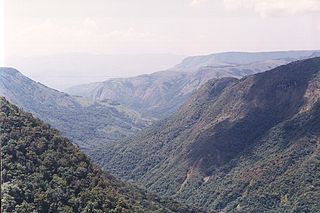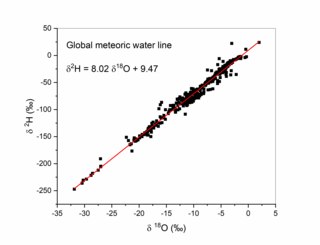Related Research Articles

Evapotranspiration (ET) refers to the combined processes which move water from the Earth's surface into the atmosphere. It covers both water evaporation and transpiration. Evapotranspiration is an important part of the local water cycle and climate, and measurement of it plays a key role in water resource management agricultural irrigation.
In statistics, interval estimation is the use of sample data to estimate an interval of possible values of a parameter of interest. This is in contrast to point estimation, which gives a single value.
Isotope hydrology is a field of geochemistry and hydrology that uses naturally occurring stable and radioactive isotopic techniques to evaluate the age and origins of surface and groundwater and the processes within the atmospheric hydrologic cycle. Isotope hydrology applications are highly diverse, and used for informing water-use policy, mapping aquifers, conserving water supplies, assessing sources of water pollution, investigating surface-groundwater interaction, refining groundwater flow models, and increasingly are used in eco-hydrology to study human impacts on all dimensions of the hydrological cycle and ecosystem services.
Robert Elmer Horton was an American hydrologist, geomorphologist, civil engineer, and soil scientist, considered by many to be the father of modern American hydrology. An eponymous medal is awarded by the American Geophysical Union (AGU) to recognize outstanding contributions to the field of hydrological geophysics. The AGU Hydrology section was formed largely due to his personal property that was bequeathed to AGU.
An isoscape is a geologic map of isotope distribution. It is a spatially explicit prediction of elemental isotope ratios (δ) that is produced by executing process-level models of elemental isotope fractionation or distribution in a geographic information system (GIS).
Equifinality is the principle that in open systems a given end state can be reached by many potential means. The term and concept is due to the German Hans Driesch, the developmental biologist, later applied by the Austrian Ludwig von Bertalanffy, the founder of general systems theory, and by William T. Powers, the founder of perceptual control theory. Driesch and von Bertalanffy prefer this term, in contrast to "goal", in describing complex systems' similar or convergent behavior. Powers simply emphasised the flexibility of response, since it emphasizes that the same end state may be achieved via many different paths or trajectories.
The Nash–Sutcliffe model efficiency coefficient (NSE) is used to assess the predictive skill of hydrological models. It is defined as:
Baseflow is the portion of the streamflow that is sustained between precipitation events, fed to streams by delayed pathways. It should not be confused with groundwater flow. Fair weather flow is also called base flow.

The HBV hydrology model, or Hydrologiska Byråns Vattenbalansavdelning model, is a computer simulation used to analyze river discharge and water pollution. Developed originally for use in Scandinavia, this hydrological transport model has also been applied in a large number of catchments on most continents.

The Global Meteoric Water Line (GMWL) describes the global annual average relationship between hydrogen and oxygen isotope (oxygen-18 [18O] and deuterium [2H]) ratios in natural meteoric waters. The GMWL was first developed in 1961 by Harmon Craig, and has subsequently been widely used to track water masses in environmental geochemistry and hydrogeology.

A hydrologic model is a simplification of a real-world system that aids in understanding, predicting, and managing water resources. Both the flow and quality of water are commonly studied using hydrologic models.

Forest floor interception is the part of the (net) precipitation or throughfall that is temporarily stored in the top layer of the forest floor and successively evaporated within a few hours or days during and after the rainfall event. The forest floor can consist of bare soil, short vegetation or litter. This throughfall is especially rich in nutrients which makes its redistribution into the soil is an important factor for the ecology and water demand of surrounding vegetation. As a hydrological process it is crucial for water resource management and climate change.
PERSIANN, "Precipitation Estimation from Remotely Sensed Information using Artificial Neural Networks", is a satellite-based precipitation retrieval algorithm that provides near real-time rainfall information. The algorithm uses infrared (IR) satellite data from global geosynchronous satellites as the primary source of precipitation information. Precipitation from IR images is based on statistical relationship between cloud top temperature and precipitation rates. The IR-based precipitation estimates are then calibrated using satellite microwave data available from low Earth orbit satellites. The calibration technique relies on an adaptive training algorithm that updates the retrieval parameters when microwave observations become available.

Keith John Beven is a British hydrologist and distinguished emeritus professor in hydrology at Lancaster University. According to Lancaster University he is the most highly cited hydrologist.
Elizabeth Mary Shaw was a British hydrologist and author of the popular textbook Hydrology in Practice.

Hydrology in Practice is a hydrology textbook by British hydrologist Elizabeth M. Shaw. The book was originally published in 1983 by Van Nostrand Reinhold (UK) Co. Ltd. and the most recent fourth edition was published in July 2010 by CRC Press, a division of Taylor & Francis. The book has been described as both an introductory text and a resource for professionals.
Petra Döll is a German hydrologist whose research focuses on global water resources and methods for transdisciplinary knowledge integration. She is a professor of hydrology at the Institute of Physical Geography, Goethe University Frankfurt.
Sensitivity analysis studies the relationship between the output of a model and its input variables or assumptions. Historically, the need for a role of sensitivity analysis in modelling, and many applications of sensitivity analysis have originated from environmental science and ecology.
Carol Kendall is a hydrologist known for her research tracking nutrients and contaminants in aquatic ecosystems using isotopic tracers.

Ezio Todini is an Italian academic, hydrologist and civil engineer.
References
- ↑ Beven, Keith; Binley, Andrew (1992). "The future of distributed models: Model calibration and uncertainty prediction". Hydrological Processes. 6 (3): 279–298. Bibcode:1992HyPr....6..279B. doi:10.1002/hyp.3360060305. ISSN 0885-6087.
- ↑ Beven, Keith; Binley, Andrew (2014). "GLUE: 20 years on". Hydrological Processes. 28 (24): 5897–5918. Bibcode:2014HyPr...28.5897B. doi: 10.1002/hyp.10082 . ISSN 0885-6087.
- ↑ Beven, Keith; Freer, Jim (2001). "Equifinality, data assimilation, and uncertainty estimation in mechanistic modelling of complex environmental systems using the GLUE methodology". Journal of Hydrology. 249 (1–4): 11–29. Bibcode:2001JHyd..249...11B. doi:10.1016/S0022-1694(01)00421-8. ISSN 0022-1694.
- ↑ Beven, K.J., 2007: Towards integrated environmental models of everywhere: uncertainty, data and modelling as a learning process. Hydrology and Earth System Sciences, 11(1), p. 460–467.
- ↑ Mantovan, Pietro; Todini, Ezio (2006). "Hydrological forecasting uncertainty assessment: Incoherence of the GLUE methodology". Journal of Hydrology. 330 (1–2): 368–381. Bibcode:2006JHyd..330..368M. doi:10.1016/j.jhydrol.2006.04.046. ISSN 0022-1694.
- ↑ Beven, Keith; Smith, Paul; Freer, Jim (2007). "Comment on "Hydrological forecasting uncertainty assessment: Incoherence of the GLUE methodology" by Pietro Mantovan and Ezio Todini". Journal of Hydrology. 338 (3–4): 315–318. Bibcode:2007JHyd..338..315B. doi:10.1016/j.jhydrol.2007.02.023. ISSN 0022-1694.
- ↑ Stedinger, Jery R.; Vogel, Richard M.; Lee, Seung Uk; Batchelder, Rebecca (2008). "Appraisal of the generalized likelihood uncertainty estimation (GLUE) method". Water Resources Research. 44 (12). Bibcode:2008WRR....44.0B06S. doi: 10.1029/2008WR006822 . ISSN 0043-1397.
- ↑ Sadegh, M.; Vrugt, J. A. (2013). "Bridging the gap between GLUE and formal statistical approaches: approximate Bayesian computation". Hydrology and Earth System Sciences. 17 (12): 4831–4850. Bibcode:2013HESS...17.4831S. doi: 10.5194/hess-17-4831-2013 .
- ↑ Nott, David J.; Marshall, Lucy; Brown, Jason (2012). "Generalized likelihood uncertainty estimation (GLUE) and approximate Bayesian computation: What's the connection?". Water Resources Research. 48 (12). Bibcode:2012WRR....4812602N. doi: 10.1029/2011WR011128 .